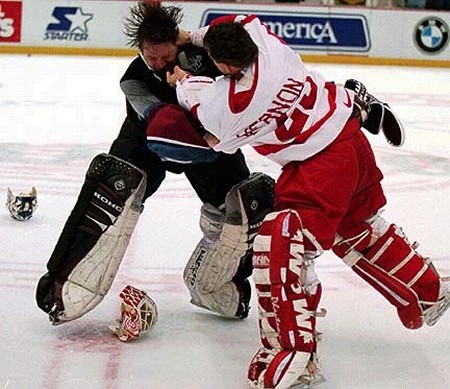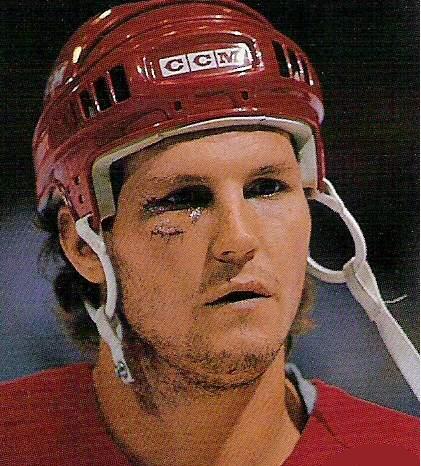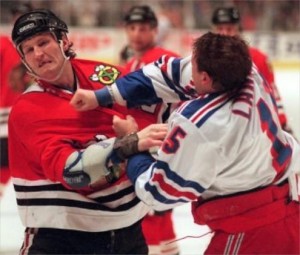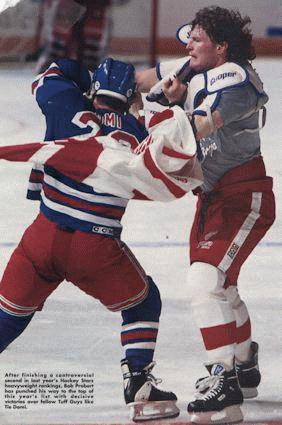After my post yesterday, “Back To The Future With Old Time Hockey?”, wherein I acknowledged –and celebrated– the recent trend of accountability and team-toughness in our most misunderstood sport, it was inevitable that at least one of my well-meaning friends would take exception. It was my good luck that it turned out to be one of my most intelligent and savvy amigos, who knows a lot about sports (soccer in particular) and life (in general); a dude whose opinion I always appreciate. And so, with gratitude, I will take his comments as an opportunity to say more about my feelings toward hockey (in general) and hockey fighting (in particular). I hope in the process I at least address some of his remarks to his satisfaction, and stimulate some thoughts from others, especially non-hockey fans.
2/12/2011, 8:50pm:
Seany-boy, I remember when I was in High School, someone said to me: “Why don’t you like hockey? It’s actually a lot like soccer.” My response was: “Oh, bullshit. In soccer I can dribble around someone with skill. If I beat them, I beat them. If I don’t, I don’t. We pit our skills against one another and see who comes out on top. Not so in hockey. In hockey, if I beat someone on skill they can just knock me on my ass. Or someone else can knock me on my ass. It’s redneck soccer – a crass, hollow husk of a sport.”
I hate to say it, but my opinion stands. All this emphasis on fighting is exactly what I expect from NASCAR fans, who, when faced with a couple consecutive accident-free races stare slackjawed and complain about the lack of carnage, instantly forced to confront how inherently boring their sport is.
Hahahaha!
2/13/2011, 10:21am
Sensh,
Needless to say, I violently (ha!) disagree.
However, I have heard similar sentiment expressed by friends (who love and understand other sports) over the years. I think it’s more than a little ironic, yet for purposes of this discussion, wonderfully appropriate, that you advocate soccer at the expense of hockey. Indeed, if there is one sport more unfairly maligned than soccer, I can’t think of it (I would say hockey, but as I readily concede, no one actually watches hockey!). Having found myself, on too many occasions to count, defending the great sport of soccer from simpletons who consider it “boring”, I can’t help but be amused by the fact that, of all things, you use the word “boring” to describe the one sport where there are no timeouts, no diving, and no malingering (hello baseball!)
Doesn’t it drive you nuts when bozo-Americans say “nothing *happens* in soccer?” The only answer, which could never satisfy the unimpressed fan (who probably prefers the wrong type of football) is that *everything* happens in soccer, it just happens in its own way, at its own pace, by its own logic, and in a fashion that should not –and cannot– be compared to other sports. Since we are simpatico on this, I won’t belabor the point; I suspect we probably have used similar arguments, however futilely, to try and enlighten non-soccer fans. That said, I also have to acknowledge some of the issues non-fans have with the game (even, if especially the game at its highest level: during world cup competition). The diving and drama has long-since gotten way out of hand; it denigrates the game to a considerable extent and drives me nuts. The (understandable, but infuriating) tendency of teams, if they happen to score first, to shut everything down and play ultra-conservative in the hopes of maintaining their lead. The embarrassing savagery of the fans (ever read Among the Thugs? by Bill Buford? Highly recommended).
And, I suspect, any serious fan of soccer with a modicum of sociological perspective innately understands that even the hooliganism is rooted in class and economic context; in other words, even that indefensible aspect of the game is more complicated, historically inculcated and, yes, explicable than a casual assessment would suggest. (Lest that sound like I am in any way defending or advocating soccer-related shenanigans, I am not; only recognizing that it has a lot more to do with things aside from a taste for “a bit of the old ultraviolence”…which, in another discussion, could conceivably bring us back to hockey and its origins which are not unlike lacrosse, a game initially played—in very brutal fashion—by the Native Americans. More on that later, as well as the socioeconomic elements of hockey’s origins and ongoing association with a very blue-blood—and blue collar—populace in the Great White North also called Canada.)
That said, when people claim soccer players are soft, I like to say the same things I tell people when they make fun of tennis: try running around for 90 minutes. Not even in the context of a game; just the simple fact of RUNNING AROUND for 90 min. Ah yes, but that just means they are in shape, the people inexorably say. Okay, try and maneuver a soccer ball, while running and having people stick their feet, arms, shoulders, and torsos at and around you. (Just like it’s always humbling, to this day, to think I’ve got some game when I play b-ball and shoot around with myself, draining all my shots; then get into some on-court action vs. actual people and I realize, instantly how short, weak and white I am).
The best part, to me, is that of all the sports, soccer and hockey are most similar. If you watch a hockey game you’ll see the similarities are astonishing: it’s just that everything is faster and (sorry) much more intense. The “field” is smaller so there is less space, therefore more contact, and in this regard, it’s like (American) football. ON SKATES. Interestingly, for a person like yourself, you might be pleased, or at least surprised to know that the skill-set (similar to most sports) has increased incalculably over the years. Not unlike other sports (football in particular), looking back at footage even 20 years ago makes it seem that, by comparison, it used to be in black and white and slo-mo; even the fourth line players these days are in top shape, cut out of marble and fast: they are, in a sense, like linebackers, ON SKATES.
I feel, in the end, much like I do when people ask me why I listen to jazz music: because it’s great. That’s the easiest (and most truthful) answer. I have no interest in trying to convince or convert anyone; but I will say, if you are the least bit intrigued, check out hockey during the playoffs: that is BY FAR the most intense and exciting sports action you’ll see. Or, let me pull that back: certainly March Madness is tough to top; and (sigh) even NBA playoffs eventually elevate the game (where, for the duration of the regular season, most players seem to phone it in). I would say, respectfully and as a huge fan of soccer: as excited as I get for the World Cup, I’m disappointed by at least half the games (for many of the reasons listed above); I’m never, ever, disappointed during ANY games during hockey playoffs, and I could care less which teams are playing– a sentiment that exposes me as a true fan, or a hopeless case (or really, when it comes to hockey, those are the same thing).
Notice we didn’t even get into the fighting aspect yet?
I realize I could/should say more, but I already offered some opinions on this controversial aspect of the game this past July on the unfortunate occasion of Bob Probert’s passing. Probie was arguably the consensus all-time heavyweight champion enforcer (or goon, if you must) and any discussion of his life—and impact—necessarily touches on several aspects of an element of the game that entices some and appalls other. I’ll repost, below. And I definitely welcome comments, opinions and the inevitable assumption by some/many that the only thing more inexplicable than watching hockey is taking time to discuss it.
This hurts.
R.I.P. Probie.
Quick tally: #24, over 3,000 penalty minutes. Member, along with Joe Kocur, of the legendary “Bruise Brothers” tandem back in the days when the Detroit Red Wings were more feared for what they could do after the whistle stopped play. Participant in a handful of the all-time classic fights in hockey history. Man who inspired t-shirts that read “Give Blood. Fight Probert.” Simply put, if one were to try and create the ideal enforcer (especially for an era that may not have been the toughest or most iconic era but was one of the most enjoyable), one could hardly imagine a more suitable cartoon character than Bob Probert.
As The Kinks once sang, Let’s All Drink To The Death Of A Clown.
And lest anyone think I’m using the word clown carelessly or disrespectfully, it is in fact chosen with the aim of being both accurate and approbatory. (A Probie-tory, if you like.)
Think about what a clown does: he is the minor but essential character who shows up at a circus with the objective of instigating misconduct. Above all, his purpose is to entertain with a mixture of mischief and cheer. A superficial assessment might conclude that a clown is simply doing, in make-up, what any drunk idiot might do. But of course whether it is juggling, dancing or doing tricks, not just anyone could be (or would want to be) a clown. It’s a job.
Think about what a hockey enforcer (what we used to call a goon just like we used to call escorts hookers or stockbrokers sociopaths) does: he is the minor but essential figure who shows up in an arena with the object of instigating misconduct (hopefully without receiving a game misconduct). Above all, his purpose is to settle scores and entertain a crowd while invigorating his teammates. A superficial assessment might conclude that an enforcer is simply doing, in a colorful costume, what any drunk idiot might do. But needless to say, trading bare-fisted blows (sober or especially drunk) in a bar is considerably different than standing on skates and going toe to toe with an opponent who is well-prepared (and in some cases, well-paid) to kick your ass in front of thousands of people. Many people without athletic ability are very capable goons; only an extremely select group of individuals are able (much less willing) to abide by “The Code”. It’s a job.
It’s difficult to talk intelligently with anyone about hockey because so few people watch (or care) about it. That goes double when trying to articulate the science of sanctioned pugilism. How can one possibly rationalize or defend the spectacle of adults engaging in behavior that would get them arrested out in the streets? (Indeed, fans are arrested nightly at hockey rinks all over the continent for imitating, albeit often drunkenly and with far less flair, the very behavior occurring in real time below them.) The answer is at once easy and complicated, like all truths tend to be. The easy part: there is no need to explain it. If you’re not a hockey player, you can’t hope to comprehend it; unless you are a fan, you have no hope of understanding or appreciating it. It’s really that simple. Seriously. Just ask a hockey player. (And, as perspicacious commentators have pointed out for decades, one notices how nobody gets up to grab popcorn once a fight breaks out. While that may speak volumes about the distressing devolution of our species and our insatiable appetite for violence, there is something a bit more sophisticated going on.)
So what is complicated about it? For starters, hockey fighting remains a diversion that people who genuinely deplore violence (like this writer) endorse and get excited about. What does that say about us? I’m not certain. But I do know that unlike the “real” world, it is exceedingly rare for two hockey combatants to enter the fray unwillingly. Yes but, doesn’t that make it a great deal worse, if they do it because they get paid? (Well, is boxing beatiful? Brutal? Your opinion here will go a decent way toward explaining your ability, or willingness, to negotiate the enigmatic charm of the expression “five minutes for fighting”.) That gets to the not-so-easily explained sensibility of athletes (in general) and hockey players (in particular). Hockey players have traditionally been paid a great deal less than other athletes in more popular sports. It is, therefore, a bit ironic to consider that these players are more immune to pain and prone to play a regular season game like the world is on the line. It is, for hockey fans, refreshing that the players have an integrity that has been ingrained from generations and is remarkably resilient against the corrupting forces of salary, fame and product endorsements. Put in less exalted terms, people tend to get (understandably) cynical when, say, a baseball player with a multi-million dollar annual contract goes on the D.L. with a strained hamstring. That type of commonplace indifference is especially noticeable –and appalling– when one realizes that hockey players routinely return to the ice moments after receiving stitches, or losing teeth, or suffering bruised (and in some cases, broken) bones. Google it if you don’t believe me.
None of this is to say that one might enjoy the sport more if one learned more about it, but a casual viewer (or hater) might be genuinely surprised to learn a few things about the history of hockey fighting. For starters, the opposing players seldom hate each other and in it is not uncommon for them to be friends off the ice (particularly if they are old teammates). Also, the aforementioned code does have a rather elaborate –and universally endorsed– system for the rules of engagement. Finally, and perhaps most significantly: not only are enforcers generally the most popular players (amongst the fans; amongst the teams), they tend to be some of the more thoughtful and soft-spoken ones. (For two obvious examples, consider the ever-humble Craig Berube –“The Chief”– who toiled many seasons in the NHL including for my hometown Capitals and now is an assistant coach for the Flyers; then there is George McPhee who happens to be one of the more respected and successful GMs in the game.)
Of course, not all of them are model citizens, and for a variety of reasons (some understandable, some inscrutable), some of them have had very challenging and troubled lives.
Enter Bob Probert. Though it is debatable whether or not he (or any particular player) was “the best” enforcer in the history of organized hockey, not many people would argue with any credibility that he is not at least in the Top 10. For my money, pound for pound and in terms of longevity, respect, quality of opponents and success, Probert is the preeminent knuckle artist of the modern era.
Let the cliched encomiums unfurl: he feared nobody. He fought everyone. Ultimate warrior. Ideal teammate. Crowd pleaser. Accomplished actor? Well, see below:
As Detroit (and Chicago) residents know, and as fans of the game remember, Probert battled the proverbial demons off the ice as well. His struggles with alcohol and substance abuse is amply documented. His occasional escapades drew the attention of law enforcement officials. He was, in short, a troubled man in certain ways, but he was always resilient, and never let his addictions keep him down (or out).
(The actual history of his difficulties is sufficiently reported that folks interested in more can easily find out with the click of a mouse. I also acknowledge that his livelihood may have done as much to exacerbate his issues as it did to ameliorate them. In other words, he quite possibly may have gone down certain roads whether or not he played hockey or threw a single punch. But I readily concede that there is an ugly side to sports, just like there is a sinister side to life, and all of us are constantly pushed and pulled by the momentum of necessity and choice, and the inexorable reality that we have to pay bills and obey laws. A more sustained –and serious– discussion of sports, hockey, hockey fighting and some of the casualties of this game (think John “Rambo” Kordic’s tragic story) should occur at another time.)
For now, in addition to wishing him a fond adieu and sincerely sending out support and goodwill to his family and friends, I’d like to celebrate some of the most memorable instances of him doing what he did better than just about anyone who ever laced up the skates.
1. Bob Probert vs. Craig Coxe (Round One):
2. Bob Probert vs. Craig Coxe (Round Two):
3. Bob Probert vs. Dave Semenko:
4. Bob Probert vs. Troy Crowder:
5. Bob Probert vs. Tie Domi (The Epic Saga):
**Bonus: It might make sense to go ahead and include, just for the heck of it, THE BEST HOCKEY FIGHT OF ALL TIME**
Bob Probert vs. Marty McSorley (Two of the best of their generation in a game called by the best hockey announcers of their generation, Gary Thorne and the immortal and inimitable Bill Clement):
If he had kept his act together a little better, he would have retired a Red Wing, possibly kissed the Cup, and pretty much owned the Motor City. Somebody could make a movie like that. Of course, somebody already did: his name was Bob Probert and the movie was his life. Not all movies have happy endings, alas. And like anyone who will be missed once they are gone, he gave us far more than we ever gave him.




